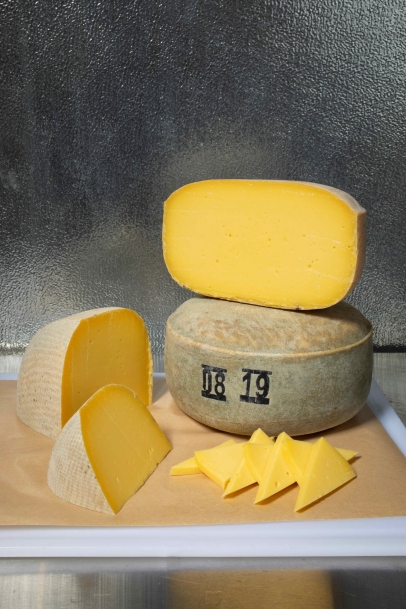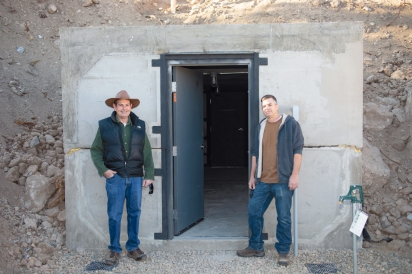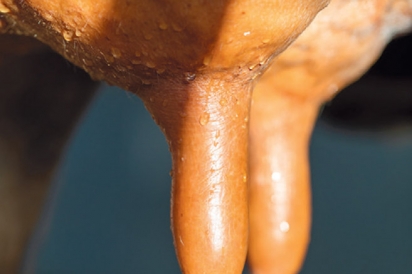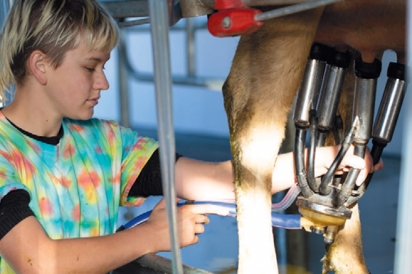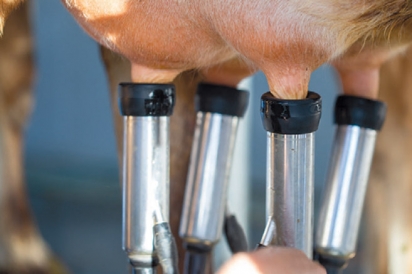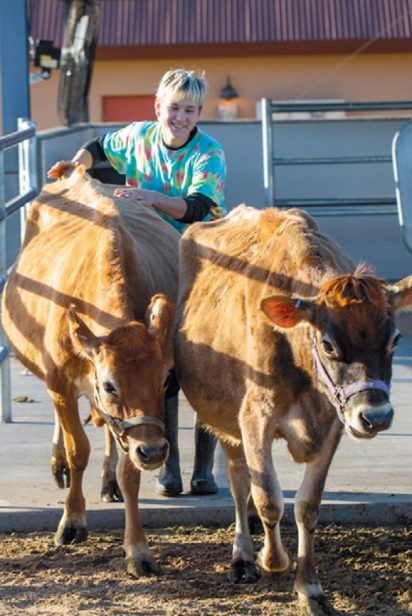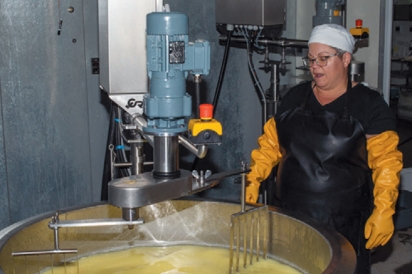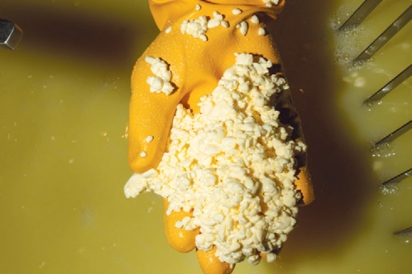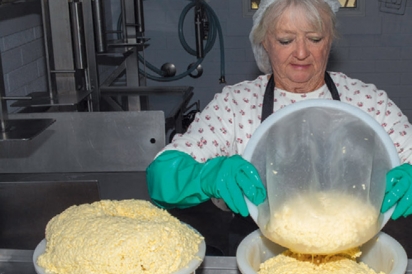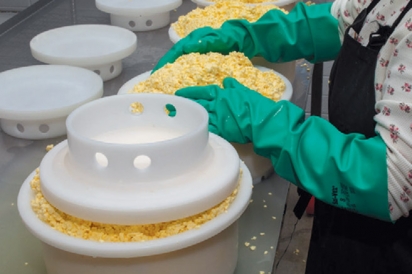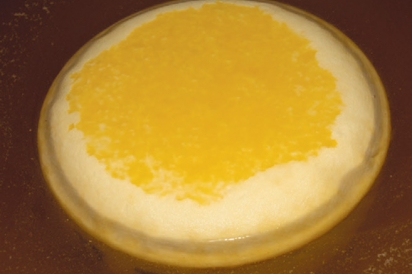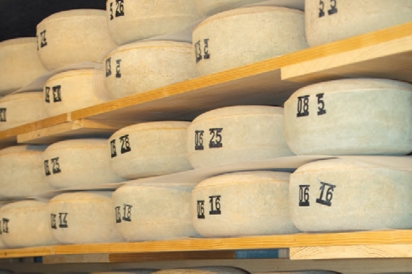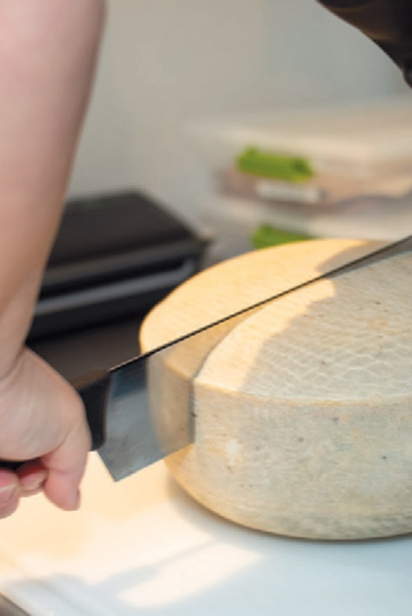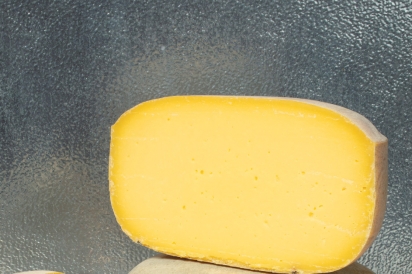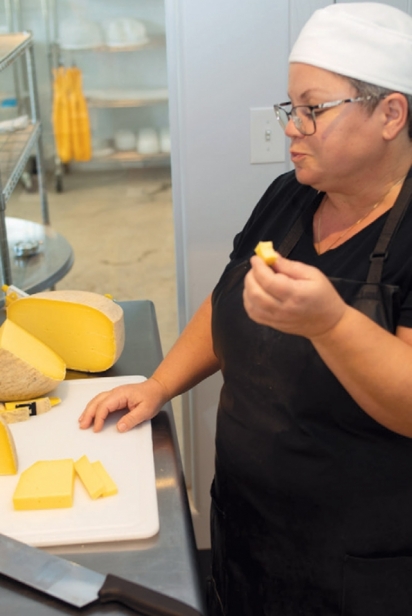Arizona Hassiago: High Desert Farmstead Cheese
After my first taste of Arizona-made “Hassiago” cheese I was smitten. It was the pale gold color that caught my eye and reminded me of fine Alpine cheeses such as Emmentaler or Cantal, recalling green hillsides and wildflower meadows.
The sample I tasted was creamy, firm and smooth, with the complex herbal flavor and nutty overtones that one gets only from aged, raw milk cheese. I just had to learn more about it.
My search led me to Hassayampa Vineyard and Farm in Kirkland, Arizona. About an hour south of Prescott and eight rolling, twisting country miles off State Route 89A, Hassayampa Vineyard and Farm is part of an unincorporated ranching community nestled in the beautiful high desert Hassayampa River Valley.
Here, amid a dense and verdant bosque of cottonwood trees and fertile bottomlands, Arizona’s only raw cow’s milk farmstead cheese is made.
Josh Meyer, the owner, has had a career in agriculture and land management for many years, and is committed to regenerative farming practices. Together with his business colleague and farm manager Jesse Couch, he started out growing vegetables for farmers markets.
Encouraged by his friend Rod Snapp, the owner of Javelina Leap Winery, he decided in 2012 to try his hand with wine grapes. His six acres of vines produce a variety of grapes including Cabernet, Merlot, Pinot Gris and Cabernet Franc, which he grows exclusively for Javelina Leap.
In 2016 his nearby neighbor and friend Ella McCracken, a cheese afficionado and 40-year rancher of grass-fed beef, persuaded him to try cheesemaking. So, he acquired a small herd of Jersey cows from a friend in California, and Ella went to work. It took her a full year to perfect a traditional Asiago recipe adapted to the high fat content of the rich Jersey milk.
“Our farm is at about the same elevation as Asiago [Italy], with similar climate. But our cheese is different than Italian asiago, which is made with skim milk. Jersey cow milk is 35% butterfat so the same recipe yields a different result.” Additionally, Josh explains, “Asiago cheese is a protected DOP [protected designation of origin] product and can originate solely from the Asiago plateau in the Veneto foothills of northern Italy. So, we call the cheese ‘Hassiago.’ It is the product of a high desert riparian microclimate, a unique terroir.”
Hassiago is a “farmstead cheese,” which means the milk comes exclusively from the farm’s own cows, and never travels anywhere in a truck or van, never mingles with the milk from cows on other farms.
While the number varies between six and 12 milkers at one time, the herd has eight milkers right now. The cows produce [a total of] around 30 gallons of milk per day. Each batch of cheese requires 80 gallons of milk, yielding six wheels that weigh 10—12 pounds each.
Karen Nicoli signed on as apprentice cheesemaker to Ella McCracken in 2021. She has been working for many months to learn the complex and precise procedure of making the Hassiago. “Ella created this wonderful cheese, and I am so honored and grateful to have her mentorship,” she says.
While the milk is not certified organic, it is raw, an attribute that yields the best flavor and nutrition possible. As a “farmstead” product, the milk goes directly from the cows’ udders to the holding tank in the creamery.
Caring for the cows is humane and gentle, respecting their natural biological cycles.
“We follow the rhythm of the heifer’s calving cycle. The calves are allowed a couple of weeks of nursing. The strongest milk production occurs from two to two and a half months after calving. By Thanksgiving and through mid-January when the calves are born, there is no cheesemaking,” Karen explains.
Apart from the stringent State regulations for sanitation and record-keeping requirements for dairies and for cheese producers, the process of making the cheese is detailed and precise every step of the way—heating the milk, cutting the curds, developing and controlling the salt and acid levels of the brine, pressing the rounds, and turning and brushing the wheels as they age.
“I handle each individual cheese as it ripens,” Karen says with a big smile. “It is almost personal—a true labor of love.”
The 10- to 12-pound rounds of cheese have a firm, pale smokey-gray rind. The brine helps flavor the cheese and adds firmness to the rind. Hassiago has a rich golden-amber color. The texture is smooth, supple, somewhat dense like a good Gruyere, with a scattering of small holes. Compared to commercial U.S.— made asiago from the supermarket, the flavor is sweeter, more complex and has a distinctive mellowness that comes with the long aging of raw milk.
The wheels are aged for a minimum of four months, which gives the flavor time to develop. Josh says that people are requesting eight to 12 months of aging. The longer aging yields a slightly sharper flavor and a more crumbly, dry texture, more closely resembling a Parmesan or Romano.
(Traditional Italian artisan asiago cheese, called Asiago d’Allevo, is marketed in three stages of ripeness: fresco, which is aged two to three months; mezzano, aged three to five months; and vecchio, aged nine months or longer.)
Now under construction at the farm is a large underground cheese cave, another first in Arizona. Jesse tells me that it is made with large concrete culvert forms and buried under six feet of dirt for optimal thermal control While the ambient temperature and humidity will be the same as in their current aging-room cooler, the radiant coolness of the underground cave feels noticeably different because the air is not circulating with a fan.
The cave will allow more space for longer aging and allow them to experiment with making different kinds of cheese in the future.
Karen says, “An underground cave is much more conducive to maintaining an overall environment that will keep the wheels protected while giving them the time they need to ripen. Wheels will still be cared for by hand, turning and rubbing the natural rind until it has completed its affinage. I’m excited to ‘get to know’ the cave when it’s ready to receive the cheeses!”
To my palate, the crew at Hassayampa Vineyard and Farm has achieved a truly noteworthy raw milk cheese in league with the best alpine cheesemaking traditions. I am excited to try the underground cave-aged cheese and look forward to the possibility of other raw milk cheeses from this talented artisan team, who have painstakingly captured the terroir of the Arizona highlands.
Hassayampa Vineyard and Farm
hassayampavineyardandfarm.com, 928-427-6445
WHERE TO FIND HASSIAGO
Currently marketed by personal contact and word of mouth, Hassiago cheese is available for purchase at these Valley locations:
• Arcadia Meat Market, E. 3950 Indian School Rd. #130, Phoenix; arcadiameatmarket.com
• Hidden Track Café, 111 W. Monroe St., Phoenix; hiddentrackcafe.com
• Mingle and Graze, charcuterie boards and boxes, 48 S. San Marco Pl., Chandler; mingleandgraze.com
The cheese is served on the menu at these establishments:
• Bacanora, 1301 NW Grand Ave. Unit 1, Phoenix; bacanoraphx.com
• Far Away Wine and Provisions, 3031 E. Indian School Rd. #10, Phoenix; farawaywineaz.com
• Superstition Meadery, 120 W. Gurley St., Prescott; superstitionmeadery.com
• Valentine, 4130 N. 7th Ave., Phoenix; valentinephx.com (see page 8)
THE AGING PROCESS FOR HASSIAGO
• From raw milk to formed rounds, the cheese process takes 10 hours from start to finish.
• Then the rounds sit for 48 hours.
• They are then gently pressed for another 48 hours, after which they are brined for 48 hours. The brine is carefully prepared with reverse-osmosis water, salt and citric acid.
• Once brined, the wheels rest on native wood boards in the temperature- and humidity-regulated cheese room.
• As the cheese rests and the rind hardens, Karen wipes and cleans the rounds with a linen cloth or scrubs them with a bristle brush. She then turns the rounds weekly, like Champagne bottles, for optimal ripening.


